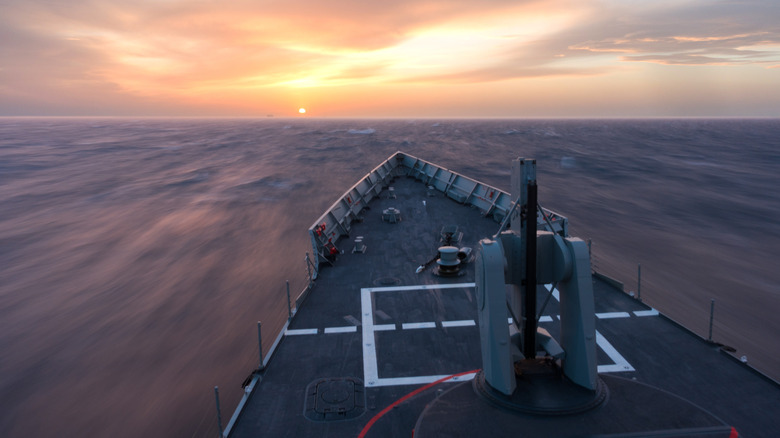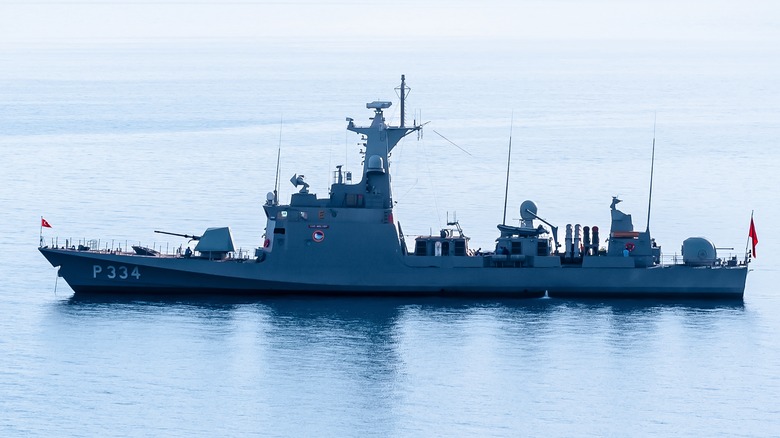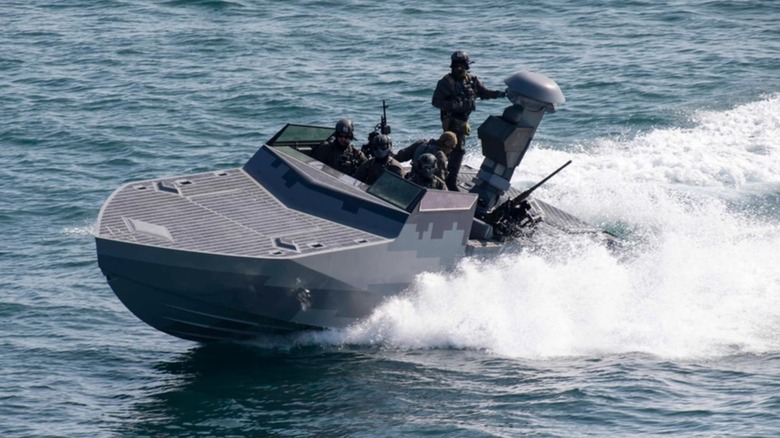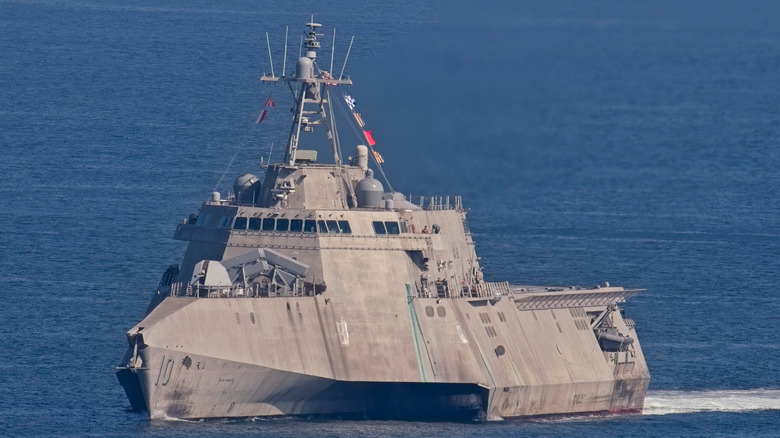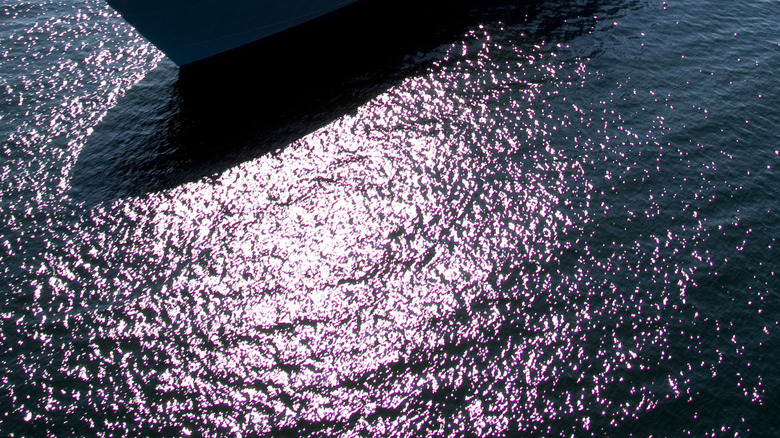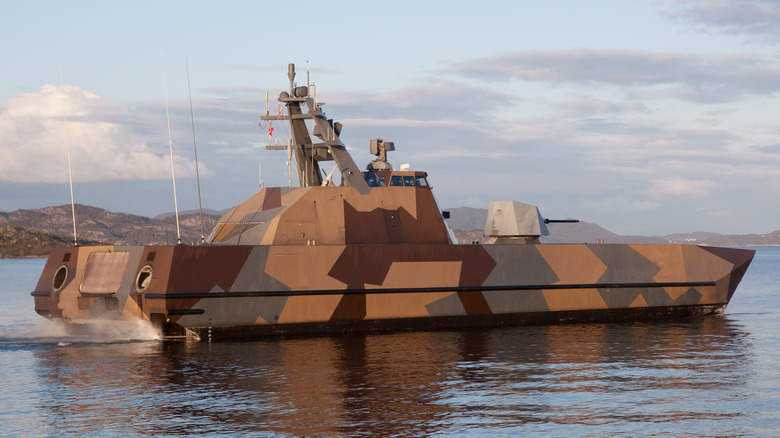5 Of The Fastest Navy Ships Ranked By Top Speed
Speed is hardly paramount for naval vessels — it's not always going to be the feature that wins a battle or even a war — but it doesn't hurt. Depending on the type of ship, speed can be the difference between life and death for the sailors aboard.
Speeds on the ocean feel different than ones on land. Gerald R. Ford-class carriers can travel at roughly 30 knots (34.5 mph), which might not seem fast if you drive faster than 60 mph in your car. But when you take into account that they're 100,000-ton vessels that have to rip through choppy waves to reach those speeds, it should put things in perspective. So when vessels can go faster than 30 knots, they're worth noting.
Other naval vessels have exceeded the speeds of the following ones, but for this story we were looking for vessels still serving in the military one way or another. Even if that means it's exclusively used for training, we wanted to include it. But vessels that aren't still used had to be left out. For instance, because every Cold War-era A-90 Orlyonok Ekranolplan, which exceeded 216 knots for the Soviet Union, was retired by 1993, it didn't fit what we were looking for. Instead, here are some of the fastest naval ships still in operation somewhere in the world.
Kılıç class (40 knots)
The Turkish Navy isn't one the public hears too much about, but it owns some of the fastest ships on the water. That would be Turkey's Kılıç I/II class of fast attack ships.
The first of its kind, the Kılıç, was commissioned in 1998. It and the following two (the Kalkan and the Mizrak) comprise the Kılıç I class, while the latter six make up the Kılıç II variant. Their electronic equipment, specifically the fire control tracking system, is what separates these two variants from each other., along with the main gun's housing. When weather permits and the water conditions are ideal, the Kılıç-class can reach speeds of 40 knots (46 mph). Even when the waters are extemely turbulent, the ships are capable of more than 24 knots (27 mph).
This small 552-ton vessel has four MTU-brand main engines that power four propellors with two rudders. These diesel engines are capable of producing 22,000 horsepower. Not only is the Kılıç I/II class fast, these ships have a small radar cross-section, making them harder to detect than some rival ships.
Navy SEALs' Combatant Craft Assault boat (40 knots)
Most details about the Navy SEALs — or special forces in general — are redacted for national security. That's especially true for the awesome vehicles SEAL teams use in the field. But we do know some things about the specialized watercraft they've used over the decades.
In 2015, the Navy replaced the Mark V Special Operations Craft with the new Combatant Craft Assault high-speed boat, which can rapidly insert and extract SEALs behind enemy lines. Despite military secrecy, it's possible to infer some details about the CCA if we look at similar boats. For starters, it can exceed 40 knots (46 mph) and might even be able to race closer to 55 knots (63 mph). United States Marine Inc., which builds the 41-foot CCA, also makes a similar vessel that's 2 feet longer and can go over 55 knots in calm seas.
The CCA uses a surface-drive system of surface-piercing propellers known for its speed. These propellers are designed to work partly out of the water, significantly reducing drag. Because of the position of the propellors, there's no blade-tip clearance from the hull, letting operators use a variety of propellor sizes. This is especially helpful for special forces, as the CCA can easily soar through the shallows. This high-speed boat isn't restricted to being launched from a dock or larger ship, either, as it's light enough for a C-17 to carry and drop it into the ocean from midair.
Independence-class combat vessels (44 Knots)
In the early 2000s, General Dynamics devised an idea for a small, agile warship that could operate with ease near the shore, in the "littorals." Lockheed Martin was working with Marinette Marine already to build such a vessel, but the Navy accepted General Dynamics' proposal, contracting with the firm to build two warships before awarding a larger deal to either firm. Partnering with Austal USA, the result was the Independence-class Littoral Combat Ship.
The Independence variant is deceptively fast with its wide stern, accommodating the largest flight deck on current surface combatant vessels, and trimaran hull design that increases its total surface area. Despite all that, it can still exceed 44 knots (50 mph). It's built with a combined diesel and gas turbine propulsion system that uses two General Electric LM2500 gas turbines, two MTU Friedrichshafen 20V8000 series diesel engine, and four Wärtsilä waterjets.
In 2010, Navy leaders asked for Congress to approve 10 Independence-class vessels. They got their wish, and more. There have been 18 Independence ships built, with a 19th currently under construction.
Freedom-class combat vessels (47 Knots)
Alongside the construction of the Independence class, a Lockheed Martin-led team designed and built the Freedom-class Littoral Combat Ship. No other vessel exudes "America" more than a class of ships named Freedom, and not simply because of its name. American culture is seeped in the mentality that everything manufactured there needs to be bigger, stronger, and faster than everywhere else.
Like the Independence class, the U.S. Navy commissioned the Freedom class to combat dangers in the littorals, such as mines, diesel submarines, and other fast attack craft. When it comes to other speedy vessels, the USS Fort Worth, Detroit, or any of the other 13 Freedom-class ships won't have much of an issue closing the distance.
In collaboration with Marinette Marine, Lockheed Martin's final design produced a vessel capable of 47 knots (54 mph). Again like the Independence class, the Freedom class is built with a combined diesel and gas turbine propulsion system, but it uses two Rolls-Royce MT30 gas turbines, two Colt-Pielstick 16PA6B diesel engines, and four Rolls-Royce Kamewa 153SII waterjets, two of which are maneuverable.
As fast as this class is, it hasn't been without its headaches, specifically related to its propulsion system. A damaged clutch between the gas and diesel turbines caused the Milwaukee to be without any propulsion in the middle of the Atlantic Ocean, requiring a tow. A year later, the same thing happened to the Fort Worth in the Pacific.
Skjold-class corvette (60 knots)
The Royal Norwegian Navy has the honor of utilizing one of the fastest naval vessels to hit the open seas. If weather conditions are ideal and the water is calm, the Skjold class has been known to reach 60 knots (69 mph).
The Royal Norwegian Navy commissioned the first of this class of corvette, the Skjold, in 1999 and in 2002, it ordered five more. The Skjold visited the United States for 13 months, giving the U.S. Navy a look at its design and capabilities. It returned to Norway in 2002 and then in 2003 the Navy decommissioned it in order to upgrade its propulsion system. The Norwegian Navy recommissioned it in 2008 when it was redesignated as a trials platform.
The five corvettes to follow the namesake vessel (Storm, Skudd, Steil, Glimt, and Gnist) were built with a combined diesel and gas turbine propulsion system using four Pratt & Whitney gas turbines that drive two Kamewa water jets. Its speed is greatly assisted by its air-cushioned catamaran hull, providing less surface area to get wet, thus reducing resistance from the water it rides on. Moreover, this design makes it ideal for special operations, since it can sail through shallower water than conventional craft.
It's not merely the speed that's impressive, either. The Skjold class comes with two maneuvering engines that let it zig and zag with relative ease.
